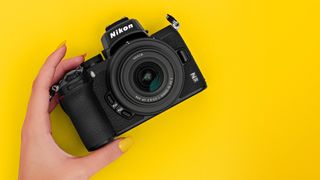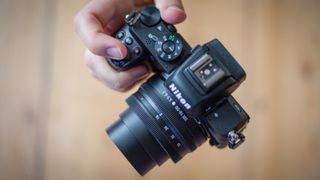The best Nikon Z50 prices and deals
These are the best Nikon Z50 deals we can find right now

These are the best Nikon Z50 deals available right now? Then you're in the right place, as we have all the up-to-date prices to help you find yourself a bargain.
STOCK UPDATE! With the pandemic and resulting electronic chip shortages causing havoc in the global camera industry, retailers are struggling to stock enough of some of the most popular camera models. But don't despair! We've scoured the web to find retailers near you who'll either have the Nikon Z50 in stock right now, or else available for pre-order. Scroll down to see today's best prices...
The Nikon Z50 is the third of Nikon's Z family of mirrorless system cameras. But unlike the Nikon Z5, Nikon Z6 and Nikon Z7, the Z50 does not have a full-frame image sensor – instead it uses a smaller APS-C CMOS sensor - similar to that found in Nikon's DX-format DSLRs.
The smaller sensor means that you get a smaller and affordable camera – but one that can use the large-aperture Z mount lenses used by its older, more expensive brothers. But it can also use some smaller lenses to create a highly portable package - such as the Nikkor Z DX 16-50mm f/3.5-6.3 VR and Nikkor Z DX 50-250mm f/4.5-6.3 VR that come in with the attractively-priced twin-lens kit version of the Z50. The camera can also be used with older-generation Nikon F-mount lenses via the optional Nikon FTZ adaptor.




The best Nikon Z 50 deals
Nikon's first APS-C mirrorless camera is winner
Type: Mirrorless | Sensor: APS-C CMOS | Megapixels: 20.9MP | Monitor: 3.2-inch tilting, 1.04m dots | Continuous shooting speed: 11fps | Viewfinder: EVF, 2.36m dots | Max video resolution: 4K UHD at 30p | User level: Beginner/enthusiast
The Nikon Z50 is small, but it has been deliberately designed so that it is still easily to hold, and to use like a true enthusiast camera. There is a decent-sized grip, for instance, meaning that you can hold it firmly in your right hand without the feeling that you might drop it. And there is a high-quality 2.36 million electronic viewfinder - so you can use the camera at eye-level and see what you are shooting (and have shot) at eye-level in all lighting conditions. This is coupled with a 3-inch tilting LCD screen, that can be used to take low-angle shots, or even shots from above your head. Crucially for vloggers (and selfie lovers) the screen can be tilted to face forwards - so you can keep yourself in shot as you record.
The stills side of the camera delivers 20 megapixel images - and can shoot these at up to 11 frames per second. There is no built-in stabilization - but as many of the lenses available have Vibration Reduction this is not a major issue. There is however electronic stabilization provided when shooting video, which can be recorded at an impressive 4K resolution without any cropping issues.

When comparing the prices for the Nikon Z50 you need to weigh up the relative merits of the different lens options available. You can find the camera available in 'body only' form - or with an FTZ mount adaptor, so that you can use you Nikon SLR lenses with the Z-mount camera. However, the best-priced options are usually those with either one or two of the Nikon Z DX zooms specifically made for the Z50; although the most expensive option, the twin-lens kit is a particularly good deal if you want an all-in-one starter system. If you are into shooting video, also consider the attractively priced Z50 vlogger kit.
Read more
• Best lenses for Nikon Z50
• Nikon Z lens roadmap: everything we know
• The best Nikon Z lenses
• The best Nikon cameras
• Nikon Z5 vs Z6
Get the Digital Camera World Newsletter
The best camera deals, reviews, product advice, and unmissable photography news, direct to your inbox!

For nearly two decades Sebastian's work has been published internationally. Originally specializing in Equestrianism, his visuals have been used by the leading names in the equestrian industry such as The Fédération Equestre Internationale (FEI), The Jockey Club, Horse & Hound, and many more for various advertising campaigns, books, and pre/post-event highlights.
He is a Fellow of the Royal Society of Arts, holds a Foundation Degree in Equitation Science, and holds a Master of Arts in Publishing. He is a member of Nikon NPS and has been a Nikon user since his film days using a Nikon F5. He saw the digital transition with Nikon's D series cameras and is still, to this day, the youngest member to be elected into BEWA, the British Equestrian Writers' Association.
He is familiar with and shows great interest in 35mm, medium, and large-format photography, using products by Leica, Phase One, Hasselblad, Alpa, and Sinar. Sebastian has also used many cinema cameras from Sony, RED, ARRI, and everything in between. He now spends his spare time using his trusted Leica M-E or Leica M2, shooting Street/Documentary photography as he sees it, usually in Black and White.